
Though the entire core of 200 Fifth Avenue was renovated into a LEED Gold, modern, Class A office building, the public only saw the restoration of the limestone façade. Inside, a new 14-story curtainwall provides natural daylight to 75% of the working spaces and outside views for 90% of the tenants.
On the corner of Fifth Avenue and 23rd Street, there sits a 100-year-old, 15-story building that overlooks Madison Square Park. Rich in history but lacking modern amenities, the International Toy Center—named for its origination as the showroom of popular toy manufacturers—was in dire need of an upgrade. Owner L&L Holding Company hired Structure Tone, a $2.5 billion New York-based construction company, to develop the building into a Class A office property. Fourteen months in the making, the entire project succeeded in earning LEED-CS Gold certification, making it the oldest building in New York to achieve the designation. Today, it’s one of the hottest properties in Manhattan.
The restoration included replacement of all mechanical systems, including HVAC, plumbing, electrical, and elevators; façade restoration, including cleaning and repairing of cracks and fissures in the parapets and limestone; installation of a new glass curtain-wall system; and the conversion of the neglected central courtyard into a landscaped, light-filled amenity for the building. The west end of the courtyard was filled in at three levels, creating a large column-free gathering space on each floor. A 14-story curtain wall captured additional floor area at each elevator core, resulting in improved circulation and 31,000 square feet of rentable real estate. More than 1,200 windows were replaced with thermally efficient windows that matched the historic sash. The lobby was updated, a deck was built on the roof, and 17 elevators were either installed or refurbished.
 Overall, the renovation provided more natural daylight, better air circulation, and increased energy efficiency, making the building more competitive in the commercial real estate market. Structure Tone reused 95 percent of the existing structure and diverted 85 percent of the construction material—including drywall, wire, steel, aluminum, glass, concrete, and tile—from landfills. They also used eco-friendly detergents to clean the façade.
Overall, the renovation provided more natural daylight, better air circulation, and increased energy efficiency, making the building more competitive in the commercial real estate market. Structure Tone reused 95 percent of the existing structure and diverted 85 percent of the construction material—including drywall, wire, steel, aluminum, glass, concrete, and tile—from landfills. They also used eco-friendly detergents to clean the façade.
Because it’s a historic-district building, much of the work on it had to be preapproved by the New York City Landmarks Preservation Commission. In addition, since the first floor was occupied by a restaurant and retailers, the life-safety system had to be maintained and a sidewalk bridge and means of egress had to be built outside to provide safety for both tenants and pedestrians. The project began with the addition of five new Con Edison electrical-service vaults. Switchboards, buss-duct risers, and the new electrical system were installed by Egg Electric. Together, the new electrical service and the new equipment upgraded the building from residential to high-voltage capacity.
A 3,200-ton, six-cell Marley cooling tower was installed on the roof. The Landmarks Preservation Commission had stringent requirements for the sightlines of the building from different vantage points, and the equipment could not extend above the existing parapets; the Marley system met the requirements. “The mechanical systems are designed to operate 15 percent more efficiently than the stringent ASHRAE requirements,” says John Travers, senior vice president of Structure Tone, who notes that 85 percent of the base-building-core electricity is offset with renewable energy and resultingly received approval from the New York State Energy Research and Development Authority.
A rooftop rainwater-capture system supplies all the water for courtyard plantings and reduces potable water needs for maintenance and irrigation by 70 percent. In addition, a highly reflective white-concrete roof reduces the heat-island effect. Concreteworks also provided custom-designed sinks for the bathrooms, which exceed water efficiency requirements by more than 20 percent. Energy-efficient appliances were installed for select tenants by Royal Rose.
On the lower floors, the floor space was expanded with a tiered atrium for private-event space on behalf of the anchor tenant. Genetech Building Systems installed a full-height glass curtain-wall system on a portion of the façade and the new atrium. The landscaping of the central courtyard extends to the setbacks at the upper floors, bringing light and views of plantings to occupants at all levels of the building. In the 6,000-square-foot, three-story lobby, a low-iron, structural glazed curtain wall was installed by AVAL. “We used a specialty glass to create a glazed façade,” Travers says. “The panes were very large—over 5,000 pounds—but they were chosen because they were energy-efficient and have an anti-reflective coating that maximizes transparency.”

Located in a historic district, the renovation to the existing building could not change the façade or interrupt the site lines of the adjacent properties. The mechanical upgrades required a new six-cell cooling tower and steel dunage be installed on the roof, which had to be hidden by the existing parapets from the Madison Square Park views.
A new fire command center and life-safety system from Fire Systems Inc. was installed at the main desk, which ties into control systems on each floor to oversee all the elevators, smoke detectors, and building speakers. Custom millwork, terrazzo floors, 250 custom LED fixtures, and two new reception desks complete the area. In the historic, double-height exterior vestibule, the original vaulted limestone ceiling, terra-cotta walls, and period fixtures were restored, and Concreteworks transformed the abandoned courtyard off the lobby into a landscaped outdoor gathering area.
With a total of 35 LEED points—including the maximum for innovation—the renovation of 200 Fifth Avenue earned LEED Gold certification under Core & Shell v2.0 and received numerous awards in 2011 alone, including the Pinnacle Award for Best Renovated Building by BOMA/NY, the Interiors Award for Adaptive Reuse from Contract Magazine, and an International Property Award for Office Architecture.

